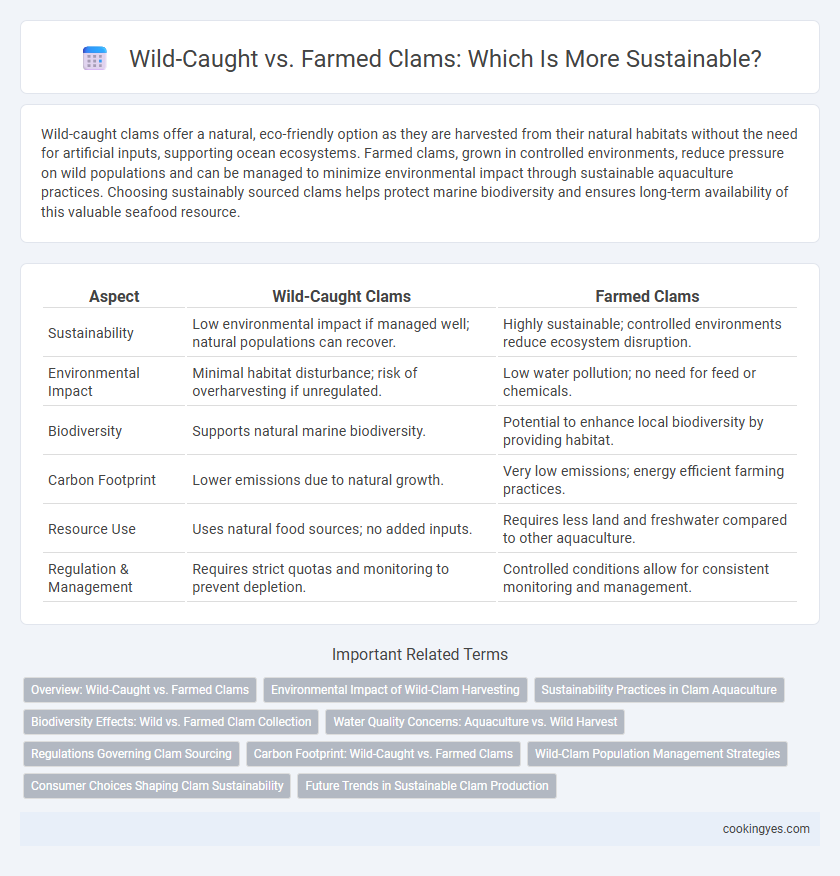Wild-caught clams offer a natural, eco-friendly option as they are harvested from their natural habitats without the need for artificial inputs, supporting ocean ecosystems. Farmed clams, grown in controlled environments, reduce pressure on wild populations and can be managed to minimize environmental impact through sustainable aquaculture practices. Choosing sustainably sourced clams helps protect marine biodiversity and ensures long-term availability of this valuable seafood resource.
Table of Comparison
| Aspect | Wild-Caught Clams | Farmed Clams |
|---|---|---|
| Sustainability | Low environmental impact if managed well; natural populations can recover. | Highly sustainable; controlled environments reduce ecosystem disruption. |
| Environmental Impact | Minimal habitat disturbance; risk of overharvesting if unregulated. | Low water pollution; no need for feed or chemicals. |
| Biodiversity | Supports natural marine biodiversity. | Potential to enhance local biodiversity by providing habitat. |
| Carbon Footprint | Lower emissions due to natural growth. | Very low emissions; energy efficient farming practices. |
| Resource Use | Uses natural food sources; no added inputs. | Requires less land and freshwater compared to other aquaculture. |
| Regulation & Management | Requires strict quotas and monitoring to prevent depletion. | Controlled conditions allow for consistent monitoring and management. |
Overview: Wild-Caught vs. Farmed Clams
Wild-caught clams are harvested directly from natural habitats, preserving their natural ecosystem but facing challenges like overharvesting and habitat degradation. Farmed clams are cultivated in controlled environments, offering a more sustainable option by reducing pressure on wild populations and maintaining water quality through natural filtration. Sustainable clam farming practices ensure a renewable seafood source while supporting ecosystem balance and reducing environmental impacts compared to wild harvesting.
Environmental Impact of Wild-Clam Harvesting
Wild-caught clam harvesting significantly alters coastal ecosystems through habitat disruption and sediment disturbance, impacting benthic communities and water quality. Overharvesting wild clams leads to population declines, affecting biodiversity and the ecological balance of marine environments. Sustainable management practices are essential to minimize environmental damage and preserve clam populations in wild habitats.
Sustainability Practices in Clam Aquaculture
Sustainability practices in clam aquaculture prioritize minimizing environmental impact through responsible site selection, waste management, and maintaining natural water quality. Wild-caught clams can cause habitat disruption when harvested unsustainably, whereas farmed clams often utilize polyculture systems that enhance biodiversity and reduce ecosystem stress. Advanced regulations and eco-certifications guide clam farmers towards practices that balance productivity with long-term ecological health.
Biodiversity Effects: Wild vs. Farmed Clam Collection
Wild-caught clam harvesting supports marine biodiversity by preserving natural habitats and maintaining ecosystem balance, as it involves selective collection that minimizes habitat disruption. In contrast, farmed clam production can lead to localized biodiversity loss due to habitat modification, nutrient loading, and potential introduction of non-native species. Sustainable clam practices prioritize wild-caught methods that protect ecological networks and promote resilient marine populations.
Water Quality Concerns: Aquaculture vs. Wild Harvest
Wild-caught clams rely on natural water bodies, which can suffer from pollution and habitat degradation, affecting clam safety and ecosystem health. Farmed clams in aquaculture systems often benefit from controlled environments that reduce exposure to contaminants and minimize environmental impact through water filtration practices. Sustainable clam farming improves water quality by filtering nutrients and sediments, whereas wild harvesting may contribute to overexploitation of vulnerable habitats.
Regulations Governing Clam Sourcing
Strict regulations govern wild-caught clam harvesting to prevent overfishing and protect marine ecosystems, including catch limits and seasonal restrictions set by authorities like the National Oceanic and Atmospheric Administration (NOAA). Farmed clams are subject to aquaculture guidelines that control water quality, disease management, and habitat impact to ensure environmentally sustainable production. Compliance with these regulatory frameworks supports sustainable clam sourcing by balancing ecological preservation with market demand.
Carbon Footprint: Wild-Caught vs. Farmed Clams
Wild-caught clams generally have a lower carbon footprint compared to farmed clams due to minimal energy input required for harvesting. Farmed clams, while needing infrastructure and maintenance, contribute to carbon sequestration by improving water quality and enhancing marine ecosystems. Evaluating the carbon emissions from fuel use and habitat impacts highlights wild-caught clams as slightly more sustainable, but responsible aquaculture practices can further reduce farmed clams' environmental impact.
Wild-Clam Population Management Strategies
Wild clam population management strategies emphasize habitat restoration, regulated harvesting, and seasonal closures to ensure sustainable wild-caught clam stocks. Monitoring population dynamics and enforcing catch limits help prevent overfishing, supporting ecosystem balance and biodiversity. These approaches sustain natural clam populations while mitigating the environmental impacts associated with intensive farmed clam production.
Consumer Choices Shaping Clam Sustainability
Consumer choices are pivotal in shaping clam sustainability, with wild-caught clams often perceived as more environmentally friendly due to their natural harvesting methods that maintain ecosystem balance. Farmed clams offer a sustainable alternative by reducing pressure on wild populations and supporting controlled habitats that minimize environmental impact. Prioritizing certified sustainable clam sources helps consumers drive demand towards practices that protect marine biodiversity and promote long-term ecological health.
Future Trends in Sustainable Clam Production
Wild-caught clam harvesting faces increasing regulations to protect natural populations, driving innovation in sustainable aquaculture practices. Advances in selective breeding, recirculating aquaculture systems (RAS), and integrated multi-trophic aquaculture (IMTA) aim to reduce environmental impact and improve yield efficiency. Emerging trends emphasize circular economy principles, with waste products repurposed to enhance ecosystem health and economic viability in clam farming.
Wild-caught vs Farmed for sustainability Infographic

 cookingyes.com
cookingyes.com